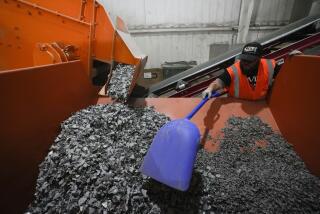The Cutting Edge: Computing / Technology / Innovation : IN DEVELOPMENT : Burn Rubber and Recycle Too
- Share via
What do you do with old tires? Turn them into planters or swings? Use them for building material? Grind them into powder for carpeting or rubber roads? Think some more: There are about 2 billion whole tires in stockpiles and landfills throughout the nation, and another 240 million are replaced on autos each year.
One answer is to recycle them as fuel. After all, the typical radial tire is made largely of synthetic rubber, carbon black and other petrochemicals. Only 3% of the tire’s content does not contribute directly to its value as an energy source. Tire-derived fuel burns cleaner and hotter and has more than 20% more heating value than coal.
Starting last month, a joint venture among Los Angeles and Riverside counties, Mitsubishi Cement Corp. and a small company called Tyres began recycling tires to provide fuel for the kilns of the four major cement manufacturers in Southern California. Cement kilns, it turns out, are ideal users of the fuel: The tire is completely consumed and becomes a part of the final product; cement quality is improved, and the wire in the tire provides iron oxide--a required raw material. Finally, the sulfur is neutralized by the limestone used in the cement process.
Sound and Slurry: Drying foods before shipping reduces freight costs and perishability. But a number of foods, such as orange juice, tomato paste and corn syrup, cannot be dried by conventional heat methods without using additives. Ingredients cooked at higher temperatures also change the chemical nature of the product.
A sonic dryer recently patented by U.S. Development Corp. and Purdue University scientists promises a remedy by substituting sound in the drying process. It relies on pulses of intense low-frequency sound waves that move relatively low-temperature air past the material. The end product is a powder that is like the original product with only the moisture removed. However, the sonic dryer works best with very wet slurries, and it is not the most effective way to make beef jerky.
New Spin on Storage: Computer hard drives, like closets, always seem to get full no matter how well you plan ahead. The problem is threatening to become worse as more information is digitized. But help is on the way.
IBM scientists have developed a sensor that will make it possible to store nearly 20 times more data on a computer hard drive. The new sensor, called a spin-value head, is five times more sensitive than today’s best commercially available disk drive sensors. That means it can read bits of data crammed more closely together on the same square inch of disk surface--in this case, a billion bits (a gigabit) per square inch.
To write information on a disk, an electrical current sent through a coil induces a magnetic field within the recording head that is projected through a small gap onto a spinning disk. To read the disk, the process is reversed.
The reading process becomes much more difficult as the size of the gap narrows because it produces an ever weaker induced current, limiting the number of bits per square inch. But the spin valve utilizes something called the giant magnetoresistive effect, which produces an electrical signal five times greater than the magnetoresistive sensors in today’s disk drives. A magnetoresistive reading sensor is made of several thin layers of a magnetic material that changes its electrical resistance in a magnetic field. The giant version is composed of even thinner film. This in turn means the sensor can read bits that take up no more than half a micron of space.
Super Glues Put It All Together: The early Egyptians knew how to weld metals together. But they didn’t have to contend with the advanced materials of today, such as specialty glasses, intermetallics, structural polymers and composites. Because of their light weight and ability to withstand high temperatures, these materials are increasingly being used in everything from aircraft and auto engines to advanced energy systems and chemical-processing plants. But joining them together is a challenge.
A number of scientists are tackling that challenge. At Rensselaer Polytechnic Institute in Troy, N.Y., Robert Messler, author of “Joining of Advanced Materials,” is studying a process known as self-propagating high-temperature synthesis. Reactions to produce oxides, carbines, aluminides, silicides and other compounds are created between the pieces to be joined, frequently under pressure. As a result, melting and bonding occur, even in instances where bonding by other means was virtually impossible.
At the University of Illinois at Urbana-Champaign, researchers have developed a glue that withstands higher temperatures than conventional epoxies. The glue is made of cross-linked copolyester, molecules of oxygen and carbon that connect in chains. They can bond to other chains anywhere along their lengths, forming a stronger product than polyesters that bond only at either end. The glue will be important for a range of products, including grinding wheels and the next generation of supersonic aircraft. The aircraft, for example, would be subject to temperatures of approximately 180 degrees Celsius. Conventional epoxies break down at temperatures above about 150 degrees C.
More to Read
Inside the business of entertainment
The Wide Shot brings you news, analysis and insights on everything from streaming wars to production — and what it all means for the future.
You may occasionally receive promotional content from the Los Angeles Times.










